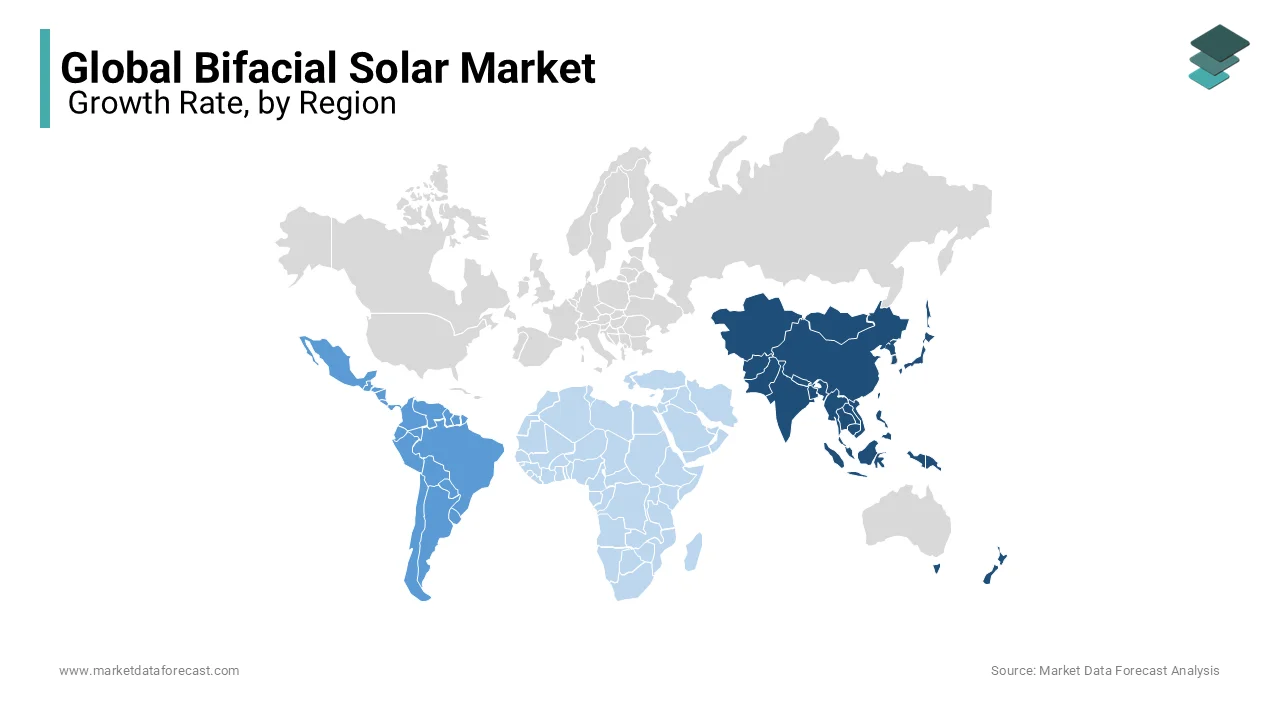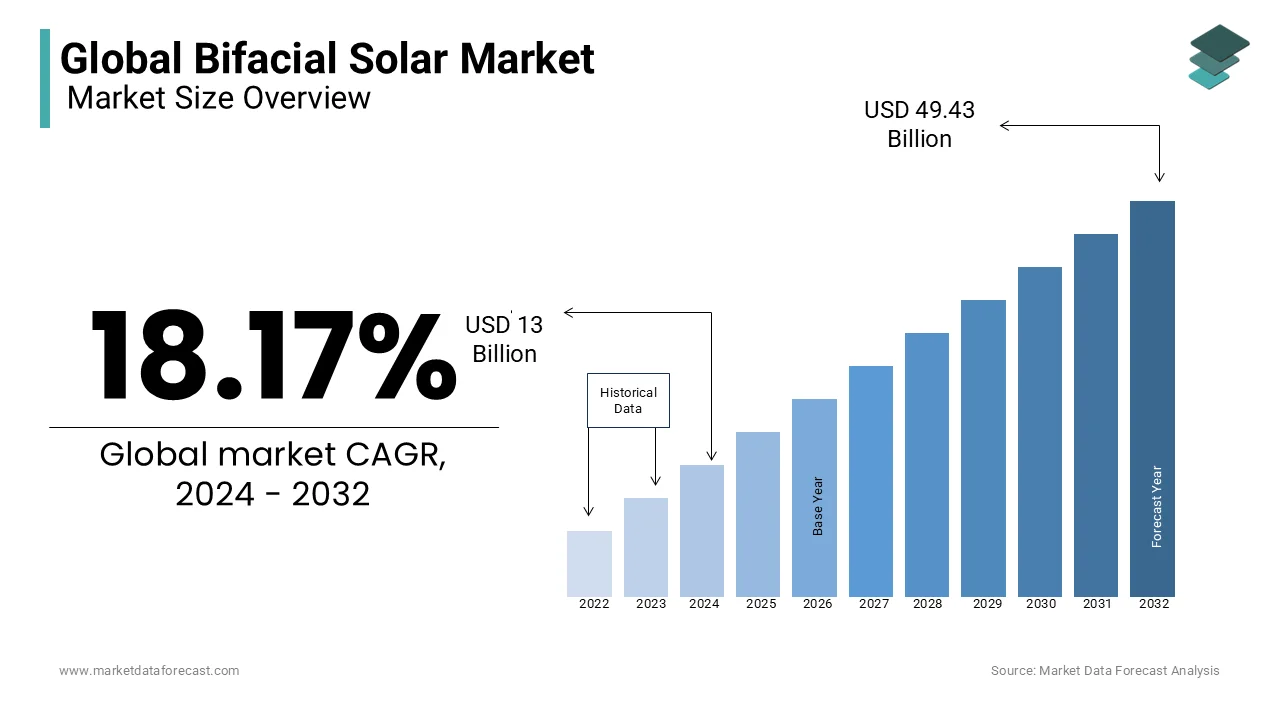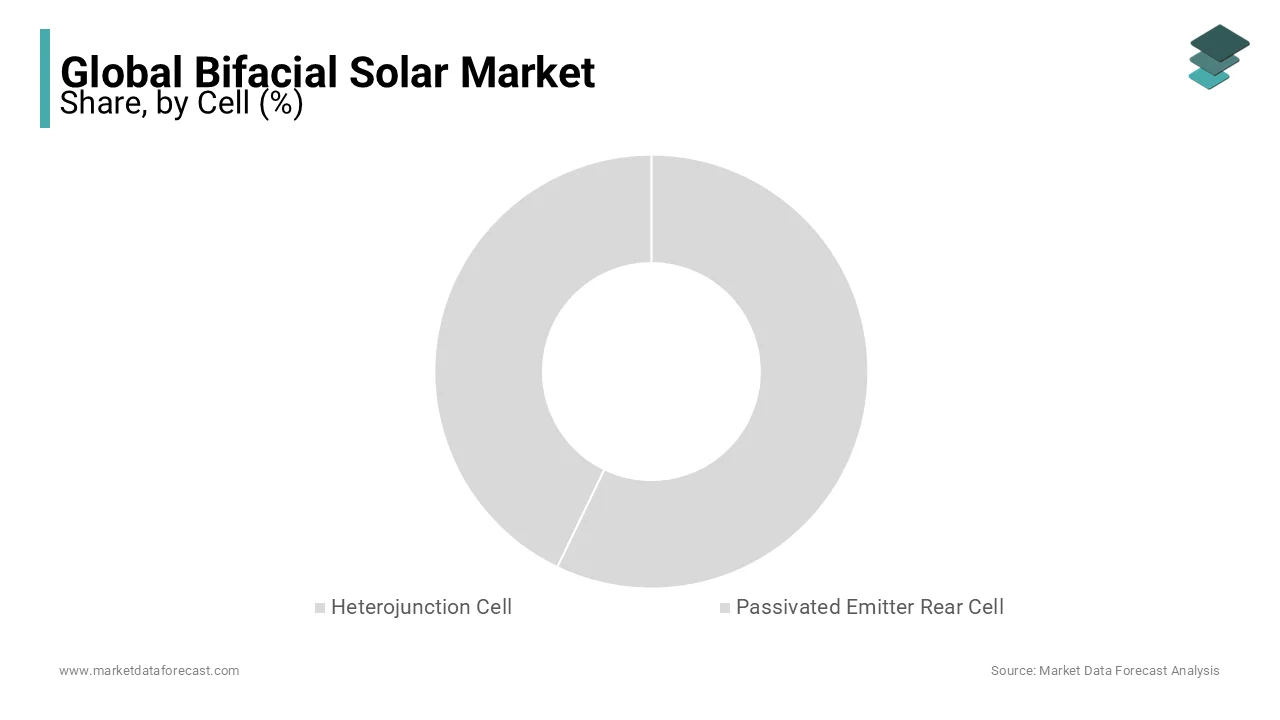Global Bifacial Solar Market Research Report - Segmentation By Cell (Heterojunction Cell and Passivated Emitter Rear Cell), By Type (Framed Bifacial Module and Frameless Bifacial Module) and Region - Industry Forecast 2024 to 2032.
Global Bifacial Solar Market Size (2024-2032):
The global bifacial solar market was worth US$ 11 billion in 2023. It is anticipated to grow at a CAGR of 18.17% from 2024 to 2032 and be worth US$ 49.43 billion by 2032, up from US$ 13 billion in 2024.
Current Scenario of the Global Bifacial Solar Market
The bifacial solar panel consists of bifacial solar cells and back cover glass. The photon that is not absorbed in the front layer can be absorbed by bouncing off any adjacent surface. This increases the efficiency of the cell. The double-glass mounting offers several benefits, like less delamination, microcracks, and moisture corrosion. They have a low degradation rate and cell temperature, high fire resistance index, mechanical strength, and less bending. Bifacial modules have approximately 3% less front surface output because light passes through the module between cells and cannot be reflected from the white back sheet as is the case with mono facial modules. The unit of measure by which photovoltaic modules are rated is Wp (watts peak). This makes sense because the power supplied by a single-sided PV installation is roughly proportional to the installed capacity and the balance of system costs is also largely determined by the installed capacity. However, as the industry grows, competition becomes more intense and manufacturers are exploiting niche industries with better prices.
Solar energy has become one of the main sources of energy. Solar photovoltaic (PV) energy is an important source of renewable energy in the world. The cost of the photovoltaic module has dropped considerably in recent years. Governments provide subsidies and encourage the deployment of solar energy on a large scale. The current discounted cost of electricity (LCOE) of large-scale PV is less than that of fossil fuels in some cases. New technological innovations, like bifacial solar panels, can further reduce the cost of electricity. The bifacial solar panel is the next-generation technology with the high-efficiency bifacial module on both sides producing electricity at the same time. It can also capture light as it reflects off the ceiling or the floor surface below the panel. Traditional solar panels have an opaque back sheet and have limited light exposure, however, bifacial panels generate power from both sides. Some manufacturers of bifacial modules claim up to a 30% increase in power generation from the rear of the panel. Bifacial solar panels come in many designs and sizes and some can be customized according to customer requirements. These panels are highly energy efficient when frameless.
MARKET TRENDS
The solar modules are aligned or even follow the sun. The back of standard solar modules receives only a small fraction of the energy captured by the front of the module. However, the rear surface can contribute 5% to 30% of the total energy balance. The word "bifacial" returns these days in the field of photovoltaics and heralds an emerging trend. Bifacial refers to a solar cell or solar module that is sensitive to light from both sides. This technology is not fundamentally new; Bifacial modules have been employed since the beginning of 1994 for applications like noise barriers on motorways. The fact that bifacial technology is gaining escalating interest can be attributed to several reasons. In general, module manufacturers continue their efforts to improve module performance and achieve added value.
MARKET DRIVERS
The bifacial solar panel absorbs the light from the back and front sides, allowing you to use the albedo and diffuse light better. Albedo light is the part of the light that hits a surface and is reflected without being absorbed.
Light scattered from any direction is known as scattered light. An efficiency increase of up to 30% is predicted, depending on things like height above ground, tilt angle, and reflectivity of the ground surface. Besides, the glass-to-glass structure offered by the bifacial solar improves the durability when compared to the conventional modules. Several current thin-film photovoltaic technologies, like CIGS and tint awareness, can easily be converted to bifacial solar panels.
MARKET RESTRAINTS
The factor that is predicted to inhibit the expansion of the market is the huge installation cost.
MARKET OPPORTUNITIES
The bifacial solar panel is available in various sizes to suit different types of requirements. Globally, solar panel prices have dropped significantly over the years, and the trend will continue throughout the forecast period. As the demand for solar electricity increases around the world, companies are offering the latest advanced solar modules focused on efficiency, cost, and design.
REPORT COVERAGE
|
REPORT METRIC |
DETAILS |
|
Market Size Available |
2023 to 2032 |
|
Base Year |
2023 |
|
Forecast Period |
2024 to 2032 |
|
CAGR |
18.17% |
|
Segments Covered |
By Cell, Type, and Region. |
|
Various Analyses Covered |
Global, Regional & Country Level Analysis, Segment-Level Analysis, DROC, PESTLE Analysis, Porter’s Five Forces Analysis, Competitive Landscape, Analyst Overview of Investment Opportunities |
|
Regions Covered |
North America, Europe, APAC, Latin America, Middle East & Africa |
|
Market Leaders Profiled |
Solar, LG Electronics, MegaCell, Neo Solar Power, Panasonic, Prism Solar, PVG Solutions, SolarWorld, Yingli Green Energy, Lumos Solar, and Others. |
SEGMENTAL ANALYSIS
Global Bifacial Solar Market Analysis By Cell
A passivated emitter rear cell is present in monocrystalline silicon versions, while heterojunction cells utilize monocrystalline silicon.
REGIONAL ANALYSIS

The Asia-Pacific bifacial solar market is likely to grow at a rapid pace during the forecast period as countries like Japan, China, and India invest heavily in the solar energy field. These countries also have the largest installed base of solar panels in the world. Latin America the Middle East and Africa are predicted to account for a moderate share of the global bifacial solar panel industry by the end of the forecast period. Europe and North America will dominate the bifacial solar panel industry due to escalated investment in solar projects in the area and are also predicted to account for a large share of the industry during the outlook period. Asia-Pacific countries like China, Australia, and Indonesia are predicted to seize the biggest industry opportunity due to the huge expansion potential of solar projects planned for the next few years.
KEY PLAYERS IN THE GLOBAL BIFACIAL SOLAR MARKET
Companies playing a prominent role in the global bifacial solar market include Solar, LG Electronics, MegaCell, Neo Solar Power, Panasonic, Prism Solar, PVG Solutions, SolarWorld, Yingli Green Energy, Lumos Solar, and Others.
RECENT HAPPENINGS IN THE GLOBAL BIFACIAL SOLAR MARKET
- Tier 1 solar module manufacturer Vikram Solar announces the availability of three new pre-order product lines in the United States, including half-cell modules rated up to 425 watts and a linear power guarantee; and the company's first glass-to-glass bifacial module with a transparent bottom architecture.
DETAILED SEGMENTATION OF THE GLOBAL BIFACIAL SOLAR MARKET INCLUDED IN THIS REPORT
This research report on the global bifacial solar market has been segmented and sub-segmented based on cell, type and region.
By Cell
- Heterojunction Cell
- Passivated Emitter Rear Cell
By Type
- Framed Bifacial Module
- Frameless Bifacial Module
By Region
- North America
- Europe
- Asia Pacific
- Latin America
- Middle East & Africa
Related Reports
Access the study in MULTIPLE FORMATS
Purchase options starting from $ 2500
Didn’t find what you’re looking for?
TALK TO OUR ANALYST TEAM
Need something within your budget?
NO WORRIES! WE GOT YOU COVERED!
Call us on: +1 888 702 9696 (U.S Toll Free)
Write to us: [email protected]

